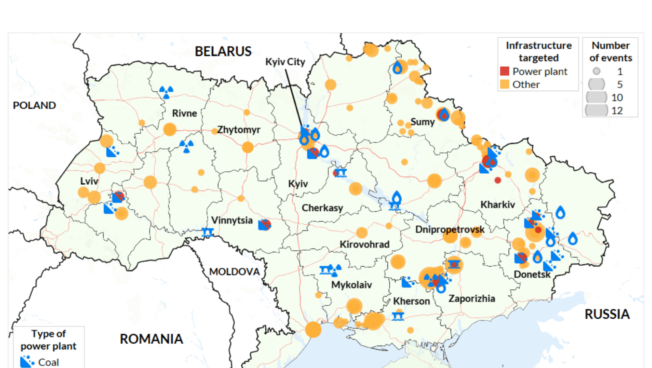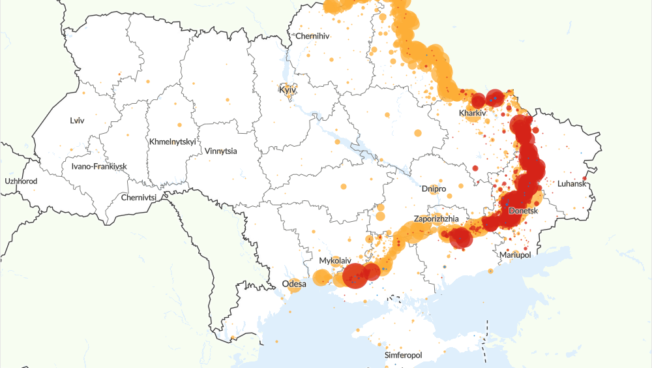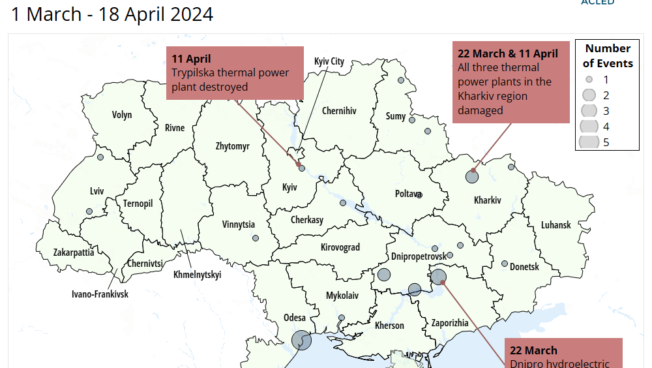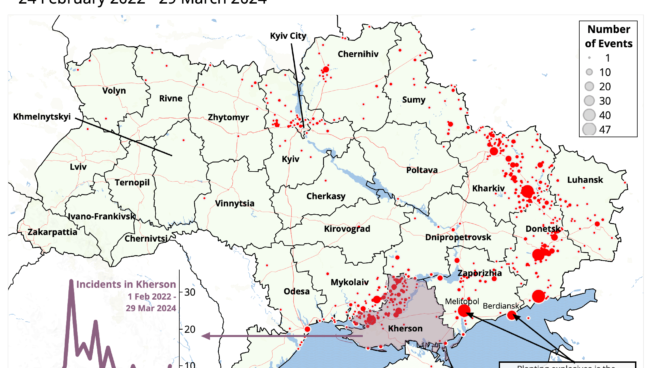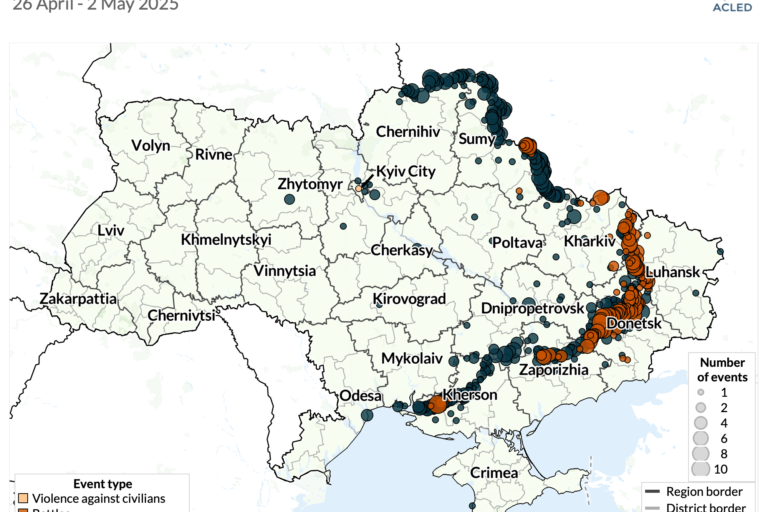Last updated: 21 May 2025
Amid the ongoing war in Ukraine, this aerial photograph shows the destruction in the village of Bohorodychne in the Donetsk region on 27 January 2024. Photo by Roman Pilipey/AFP via Getty Images
ACLED’s Ukraine Conflict Monitor provides near real-time information on the ongoing war, including an interactive map of the latest data from the start of Russia’s invasion, a curated data file, and weekly situation updates. It is designed to help researchers, policymakers, media, and the wider public track key conflict developments in Ukraine. It is released every Wednesday, with data covering events from Saturday to Friday of the preceding week and providing updates to past events as new or better information becomes available.
Ukraine war situation update
10 – 16 May 2025
Key trends
- In the Donetsk region, Russian forces continued to advance around Pokrovsk, seizing a village east of the city. Russian forces also made advances south and southwest of Kostiantynivka and west of Velyka Novosilka.
- Russian forces made gains north of Kupiansk in the Kharkiv region and near the international border with Russia in the Sumy region.
- ACLED records at least 23 Russian long-range missile and drone strikes, including in Kyiv city and the Kyiv region, as well as the western regions of Rivne, Ternopil, and Ivano-Frankivsk.
- Russian shelling, missiles, aerial bombs, and drones killed at least 18 civilians in the Dnipropetrovsk, Donetsk, Kharkiv, Kherson, and Sumy regions. Ukrainian shelling and drone strikes reportedly killed 13 civilians in the Russian-occupied parts of the Donetsk, Kherson, and Zaporizhia regions.
Key events
- 12 May | Kherson – A Ukrainian drone reportedly hits a house in Russian-occupied Chelburda, killing four civilians
- 14 May | Sumy – Russian missiles strike an industrial facility in Sumy city, killing three civilians and wounding nine
- 15 May | Crimea – Ukrainian security services strike a Russian ammunition depot near Perevalne
Spotlight: Russia demands recognition of occupied territory in talks with Ukraine
On 16 May, direct peace talks between Ukraine and Russia took place in Istanbul, Turkey, for the first time since 2022. Despite Ukraine’s President Volodymyr Zelenskyi’s proposal that he and Russia’s President Vladimir Putin hold a personal meeting, Russia sent a delegation headed by presidential aide Vladimir Medinsky.1Mehmet Guzel, Hanna Arhirova, and Suzan Fraser, “Putin spurns Zelenskyy meeting but lower-level Ukraine-Russia talks are still on,” The Associated Press, 15 May 2025 Russia also appeared to show no interest in an unconditional 30-day ceasefire, previously proposed by the US and agreed to by Ukraine. Russia has reportedly hinged its agreement to a ceasefire on Ukraine’s acceptance of extensive demands for a peace settlement.2Steve Holland, Guy Faulconbridge, and Olena Harmash, “Trump says Russia, Ukraine agree to immediate ceasefire talks, Kremlin offers no timeframe,” Reuters, 18 May 2025 These reportedly include cutting Ukraine off from Western military aid; scaling back its armed forces;3Pjotr Sauer, “Trump and Putin hold phone call but Kremlin refuses Ukraine ceasefire,” The Guardian 20 May 2025 withdrawing its troops from the entire Luhansk, Donetsk, Zaporizhia, and Kherson regions, as well as international recognition of these regions and the Crimean peninsula as Russian; neutral status of Ukraine; and no war reparations.4Anna Harvey, et al., “Russian offensive campaign assessment, May 17, 2025,” Institute for the Study of War, 17 May 2025 Ukraine’s delegation referred to these demands as “non-starters”5Patricia Zengerle, “‘Non-starter’ Ukraine talks renew call for US sanctions bill,” Reuters, 16 May 2025 that would significantly compromise Ukraine’s future security and sovereignty.
Despite the lack of progress, the delegations agreed to swap 1,000 prisoners of war each in the coming weeks.6Anna Fratsyvir, “Ukraine’s Security Service begins preparations for 1,000-for-1,000 prisoner swap with Russia,” The Kyiv Independent, 17 May 2025 To increase pressure on Russia to accept a ceasefire, the European Union began working on a new package of sanctions against Russia, targeting the Nord Stream pipelines, banking sector, and Russia’s “shadow fleet” vessels used to bypass oil sanctions.7Clea Caulcutt and Koen Verhelst, “EU eyes sanctions targeting Nord Stream and banking sector to pressure Putin,” Politico, 16 May 2025
Explore the ACLED Conflict Exposure tool to assess the numbers of people affected by armed violence, disaggregated by locations, time period, and actors involved.
Ukraine Conflict: Interactive Map
This interactive map includes political violence events in Ukraine since the start of the Russian invasion on 24 February 2022.
Date and subset filters
By default, the map displays data for the most recent week. Use the date filters to change the date range in view.
Use the subset filters to analyze trends in more detail.
Changing view
By default, the map is set to event view, which uses scaled circles to show events at a given location. Click on a region in Ukraine to zoom in for a more detailed view. Hovering over a region will give a count of events within its borders.
Changing to region (oblast) view will switch the map to a choropleth, giving an overview of event density per region. This will also disable the zoom function.
Events in Russia
While in event view, use the ‘Events in Russia’ toggle to show or hide conflict-related events in Russia. Conflict-related events are identified as follows:
- All events with the ‘Battles’ or ‘Explosions/remote violence’ event type.
- Events with the ‘Violence against civilians’ event type, where the actor is:
- Ukrainian or Russian military
- Russian border guards
- Pro-Ukrainian Russian militias
Attacks on Ukranian infrastructure
ACLED uses four automatically generated infrastructure tags when coding events that occur in Ukraine, each covering a vital sector that focuses on civilian infrastructure: energy, health, education, and residential infrastructure.
For more information, read our methodology explainer.
Event counts and civilian fatalities
The box in the bottom right hand corner displays event counts in total, disaggregated by event type, and filtered by date or subset according to the options already selected.
It also shows a conservative estimate of civilian fatalities, limited to events where civilians are targeted directly. Military casualties are not represented on the map as they are largely unverifiable.
For more information on how ACLED codes fatalities, read our methodology explainer.
Curated Data
This file contains all political violence events, demonstration events, and strategic developments recorded in Ukraine and the Black Sea from the beginning of ACLED coverage in 2018 to the present.
For an overview, see our interactive dashboard.

Ukraine & the Black Sea ( 16 May 2025 )
Attacks on Ukranian infrastructure
ACLED uses four automatically generated infrastructure tags when coding events that occur in Ukraine, each covering a vital sector that focuses on civilian infrastructure: energy, health, education, and residential infrastructure. This file contains all events featuring one or more of these tags.
For more information, read our methodology note.
Sign up for Ukraine Conflict Monitor updates
Information & Analysis
For additional information on the conflict in Ukraine, check our analysis of political violence trends from the start of ACLED coverage in 2018.

